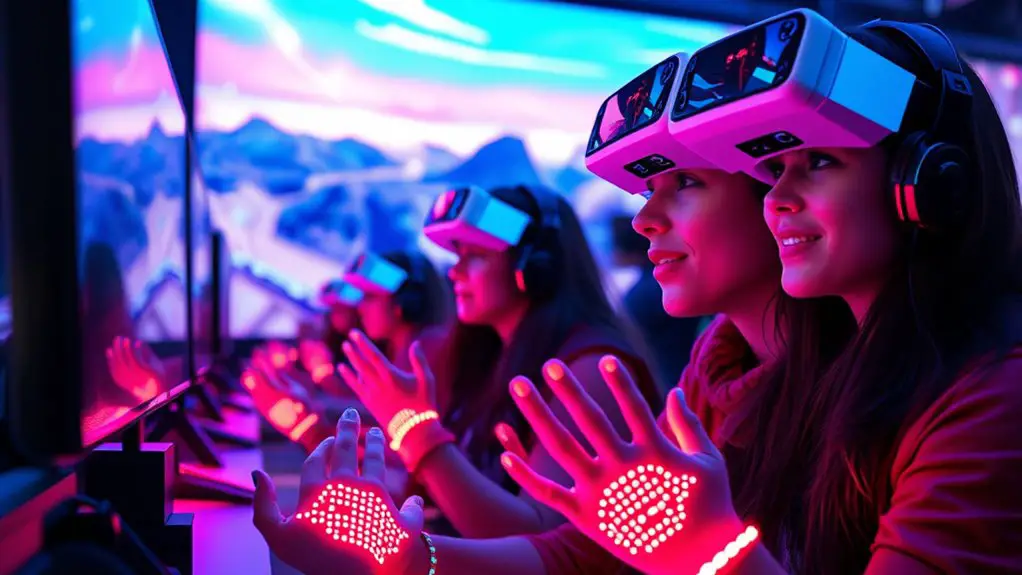The future of haptic displays in gaming is set to redefine your gaming experiences. Innovations promise precise feedback, mimicking real-life sensations that pull you deeper into the game. With developments like adaptive feedback and wearable haptic devices, you could soon feel every moment, making gaming more immersive than ever. As technology continues to advance, the lines between virtual and physical worlds will blur, enhancing your connection to gameplay. There's much more exciting progress on the horizon to explore.
Understanding Haptic Technology: A Primer
As you plunge into the world of gaming, understanding haptic technology can enhance your experience considerably. This technology revolves around haptic terminology that describes how devices create sensory feedback, allowing you to feel the game's action more vividly. Imagine the thrill of feeling vibrations as you race through a virtual landscape or the subtle resistance mimicking the weight of a weapon. This tactile immersion transforms gameplay from mere visuals to a multi-sensory adventure. By grasping the fundamentals of haptics, you empower yourself to choose games and devices that resonate with your desire for freedom in exploration. Embracing haptic feedback not only elevates your enjoyment but also deepens your connection with the digital worlds you inhabit.
Current Implementations of Haptic Displays in Gaming
Haptic displays have become increasingly integrated into gaming, pushing the boundaries of immersion and interaction. You might've experienced haptic feedback through controllers that vibrate in response to in-game events, enhancing sensory immersion. Here's a quick look at some current implementations:
| Device/Platform | Haptic Feature |
|---|---|
| PlayStation 5 | Adaptive triggers and immersive feedback |
| Xbox Series X | Enhanced vibration for environmental cues |
| VR Headsets | Full-body feedback for realistic experiences |
| Mobile Devices | Touchscreen feedback for tactile engagement |
| Gaming Chairs | Vibration synced to in-game actions |
These innovations not only elevate gameplay but also create a more engaging experience, allowing you to feel every moment as if you're truly part of the game.
Challenges Developers Face in Integrating Haptic Feedback
While many gamers enjoy the enhanced experiences haptic technology offers, developers face significant challenges in seamlessly integrating these features into their games. Haptic limitations can restrict the range and quality of feedback, making it tough to deliver immersive sensations. Integration costs often escalate, as developers must invest in both cutting-edge hardware and software development to create compatible experiences. Then there's the issue of user adaptation; not all players embrace haptic feedback, which can lead to mixed reception. Additionally, technology compatibility across different gaming platforms complicates implementation. Finally, hardware constraints may limit how developers can utilize haptics, forcing them to compromise on the immersive potential they aim to achieve. Balancing these challenges requires innovative thinking and resourcefulness.
The Impact of Haptics on Player Experience
When players immerse themselves in a game, the subtleties of haptic feedback can transform their experience from merely engaging to profoundly immersive. You'll find that haptics enhance gameplay in several ways:
- Heightened Emotional Response: Tactile feedback allows you to feel the weight of your character's actions, deepening your emotional connection to the game.
- Enhanced Realism: Immersive sensations from haptic devices can mimic real-life interactions, making every virtual moment feel authentic.
- Improved Gameplay Mechanics: With precise tactile feedback, you can react more instinctively, honing your skills and strategies in real-time.
The Future Outlook: Innovations on the Horizon
As technology continues to evolve, the future of gaming haptics promises to redefine player engagement in exciting ways. Haptic advancements are set to deliver immersive experiences that let you feel every heartbeat, explosion, and environment shift in ways you've only imagined. Picture a world where your controller or headset reacts with precision, mimicking the sensations of real-life interactions. Innovations like adaptive feedback and even wearable haptic devices could create a seamless blend between virtual and physical environments, enhancing your gaming freedom. As developers embrace these technologies, you'll find yourself not just playing a game but living it, with every pulse and vibration deepening your connection to the narrative. The horizon looks bright, and the potential is limitless.
Frequently Asked Questions
Will Haptic Displays Increase the Cost of Gaming Equipment?
Did you know that 70% of gamers prioritize immersive experiences? Haptic displays could raise cost implications, so you'll need to weigh budget considerations carefully. Investing in this technology might enhance your gaming, but it won't come cheap.
Can Haptic Feedback Be Customized for Individual Player Preferences?
Absolutely, haptic feedback can be tailored for personalized feedback, enhancing your player immersion. By adjusting intensity or type, you can create a unique gaming experience that resonates with your preferences, allowing for deeper engagement and freedom in play.
Are There Health Risks Associated With Prolonged Use of Haptic Devices?
Yes, there're health risks with prolonged haptic device use. You might experience muscle strain from repetitive motions and sensory overload from intense feedback, which can lead to fatigue. Balancing exposure is key for your well-being.
How Do Haptic Displays Affect Game Performance and Responsiveness?
Haptic displays enhance your game immersion by providing tactile sensations that mirror in-game actions, improving your responsiveness. With haptic feedback, you'll feel every impact and movement, making your gaming experience more engaging and dynamic than ever.
Will Haptic Technology Be Compatible With Existing Gaming Consoles?
You'll find haptic integration intriguing, as it raises questions about console compatibility. As technology evolves, existing gaming consoles may adapt, allowing you to experience immersive sensations that enhance gameplay and redefine your gaming freedom.

